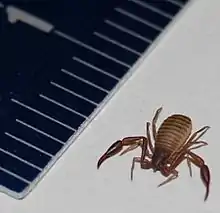Chelifer cancroides
Chelifer cancroides, the house pseudoscorpion, is a species of pseudoscorpions. It is a cosmopolitan, synanthropic, and harmless species to humans.[1]
| Chelifer cancroides | |
|---|---|
 | |
| Chelifer cancroides | |
| Scientific classification | |
| Kingdom: | |
| Phylum: | |
| Class: | |
| Order: | |
| Family: | |
| Genus: | |
| Species: | C. cancroides |
| Binomial name | |
| Chelifer cancroides | |
Subspecies
There are two subspecies:[2]
Description
Chelifer cancroides measure 2.5–4.5 mm (0.098–0.177 in) in length. The pedipalps are very long,[3] measuring 7–9 mm (0.28–0.35 in) when extended. The body is teardrop-shaped and has a rich mahogany color. The abdomen has 12 segments, only 10 of which are easily visible. The cephalothorax has one pair of eyes.[1]
Reproduction
Males maintain small mating territories, few centimeters in size. When a female enters the territory, the male initiates a mating dance and eventually deposits a spermatophore, which is then picked up by the females. Fecundity is 20–40 eggs. The development from egg stage into maturity takes 10 to 24 months and involves three molts;[1] molting may involve building a silk nest.[3] The total life span is 3–4 years.[1]
References
- Jacobs, Steve. "Pseudoscorpions". Penn State College of Agricultural Sciences Department of Entomology. Penn State College of Agricultural Sciences. Retrieved 5 May 2016.
- "Chelifer cancroides". Integrated Taxonomic Information System. Retrieved 20 June 2017.
- Levi, Herbert W. (1948). "Notes on the life history of the pseudoscorpion Chelifer cancroides (Linn.) (Chelonethida)". Transactions of the American Microscopical Society. 67 (3): 290–298. doi:10.2307/3223197. JSTOR 3223197.